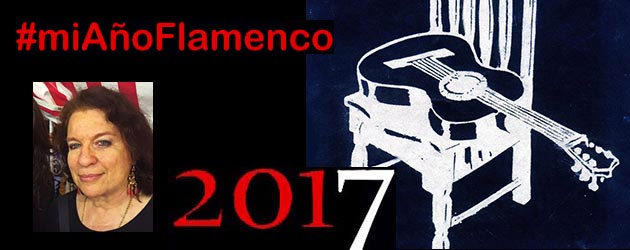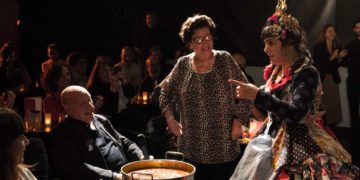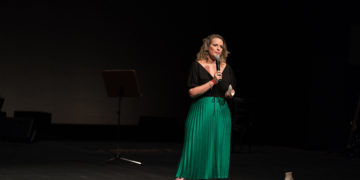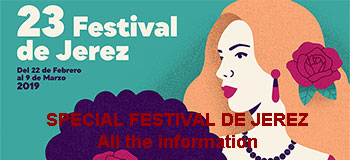Text, photo and cover image: Estela Zatania
When the new generation of flamenco fans is questioning the relevance of flamenco festivals, these classic events, and other new ones, continue to fulfill their function as a meeting point and showcase.
Fifty-seven years devoted to flamenco, seventeen with Deflamenco, and people always ask: “Don’t you get sick of flamenco?”. And each time I find myself answering “not at all!”. In fact, with the dizzying variety of interpreters and concepts, I feel like a kid in a sweet shop trying to decide what to choose. Flamenco is an ongoing experiment carried out by a bunch of people who, in the course of two centuries, have barely managed to dominate the expansive volatile nature of the creature. Long ago I sacrificed the Great American Dream for a fistful of bitter olives and some moving “cante”.
The past year was like so many others…while being different from all the others, because flamenco has that capacity for regeneration. The Festival de Jerez continued to defend its survival with a complete buffet in which each individual was able to find his or her own “purity”, whether through “Soniquetazo” with the brilliant pairing of Antonio Canales and Joaquín Grilo, the original sparks-aflying Melchora Ortega, Olga Pericet letting go as never before, Manuela Carpio “Al Compás con su Gente” with a superb Macanita, and guitarist Manuel Valencia in his best professional moment, the brilliant subtlety of Marco Flores, the fine flamenco instincts of Pastora Galván, Farruquito defending his line and his family, driving fans crazy or Antonio El Pipa once again delighting his faithful followers.
But the word “festival” applies to a variety of formats, such as the venerable summer festivals, beginning with the Potaje Gitano de Utrera that this year paid tribute to Miguel Funi with a dream program by nearly anyone’s definition: Cañeta de Málaga, Capullo de Jerez, Pedro el Granaíno…¡and the dancing of Manuela Carrasco! Soon afterwards, Mayte Martín and Argentina sang at the Gazpacho de Morón de la Frontera, and at the Reunión de Cante Jondo de La Puebla de Cazalla, it was the absence of maestro José Menese whose spirit tinged everything with special intensity.
And a new festival for Jerez, in the line of traditional summer events, brought some absolutely historic moments. The first “Festival Flamenco Jerez Gran Reserva Honores a Moraíto” featured the reappearance of Remedios Amaya, more beautiful than ever, strong and recuperated after a long illness. Also participating were Pansequito and Juan Villar, the best voices of a magnificent era that remains current. And a trio of young singers from Jerez, Manuel de la Nina, Enrique Remache and Rafael el Zambo left no doubt that classic flamenco singing still has enough vitality to keep going for a long time. But without a doubt, the most exciting moment was when Rancapino chico, accompanying dance for the first time in public, sang for Manuela Carrasco’s soleá; this young singer has been one of the most popular emerging talents of the year.
I also had the tremendous good fortune to have attended the 50th anniversary of the Fiesta de la Bulería in Jerez, a half-century of art honored and remembered in three days of the best flamenco. With “a cast of thousands”, or so it seemed, an adolescent girl managed to surprise us all. María Terremoto, daughter and granddaughter of great singers, was nothing short of sensational. It’s scary that one so young seems to already know nearly everything there is to know about flamenco, what a treasure she is, and how well she learned her lessons.
My flamenco year ended with two very rewarding events, and one sad one, that’s still hard to assimilate. Firstly, I’ll never forget the emotional reaction of the audience in Buenos Aires at the congress Fiesta, Nación y Cultura, when I projected a video of La Periñaca; then and there I understood the greatness of this unique Intangible Cultural Heritage so full of Humanity, even without having been anointed as such by the UNESCO. And secondly, having been able to validate the great but nearly forgotten maestro, guitarist Juan Maya “Marote” in his hometown of Granada, at the oldest flamenco peña in the world, La Platería. And then the sadness came, as it always does in flamenco, the terrible sadness caused by the passing of the tremendous singer, Manuel Moneo, who would lay down the law with his profound art.
And now we’re seduced by the possibilities of the year which is about to begin. The Bienal de Sevilla looming once again, the Festival de Jerez in February/March, the Nimes Festival just around the corner, the traditional summer events, and no…I haven’t tired of flamenco yet.
Descubre más desde Revista DeFlamenco.com
Suscríbete y recibe las últimas entradas en tu correo electrónico.










